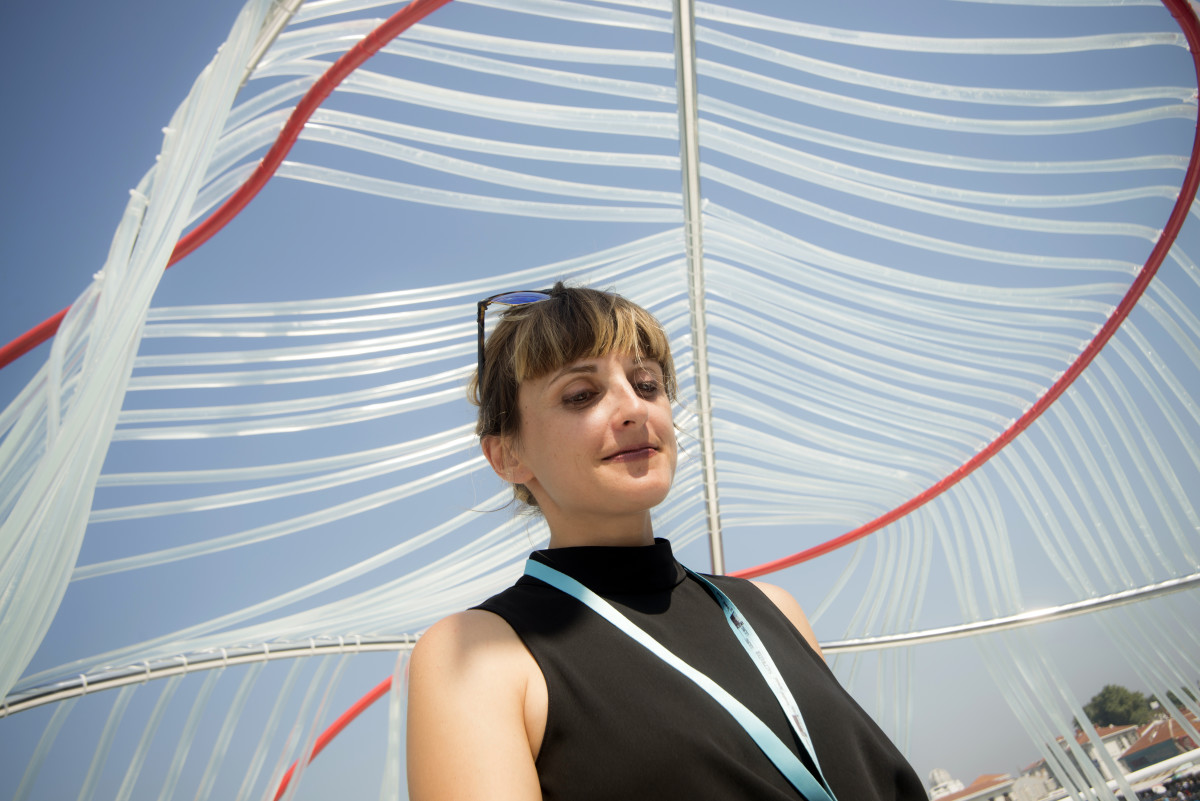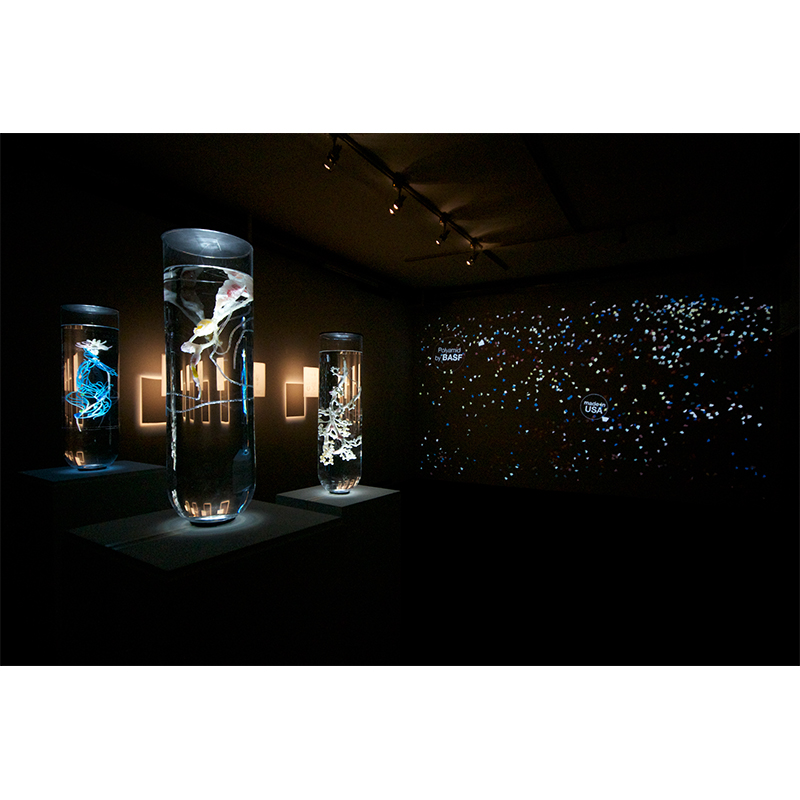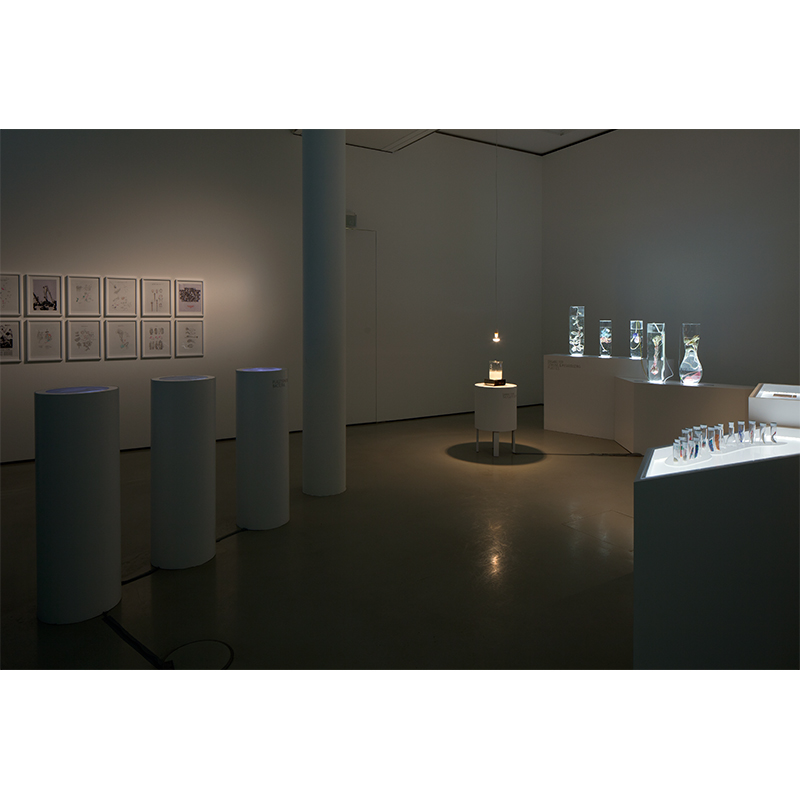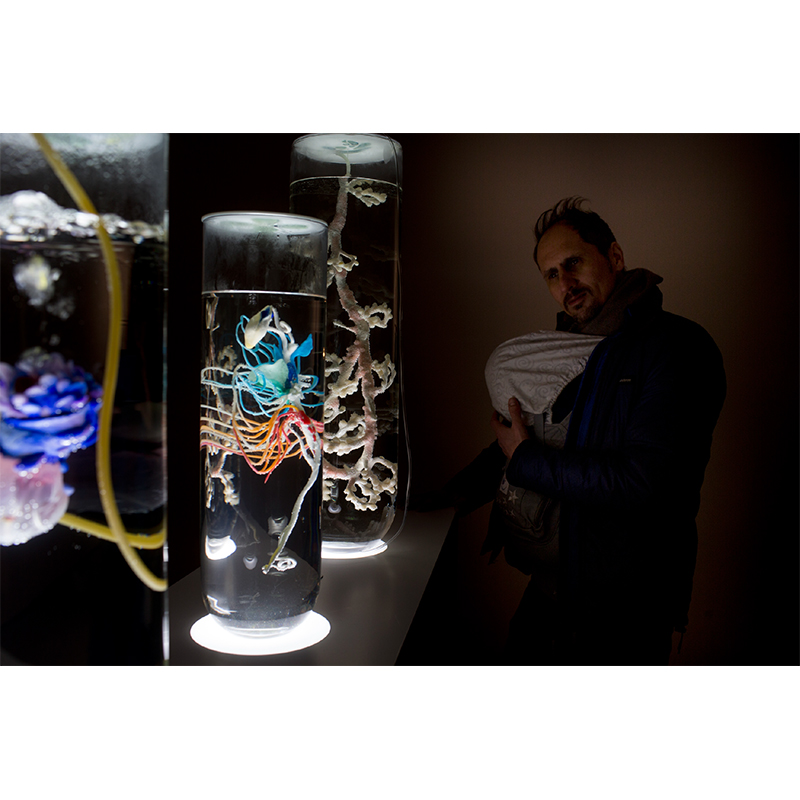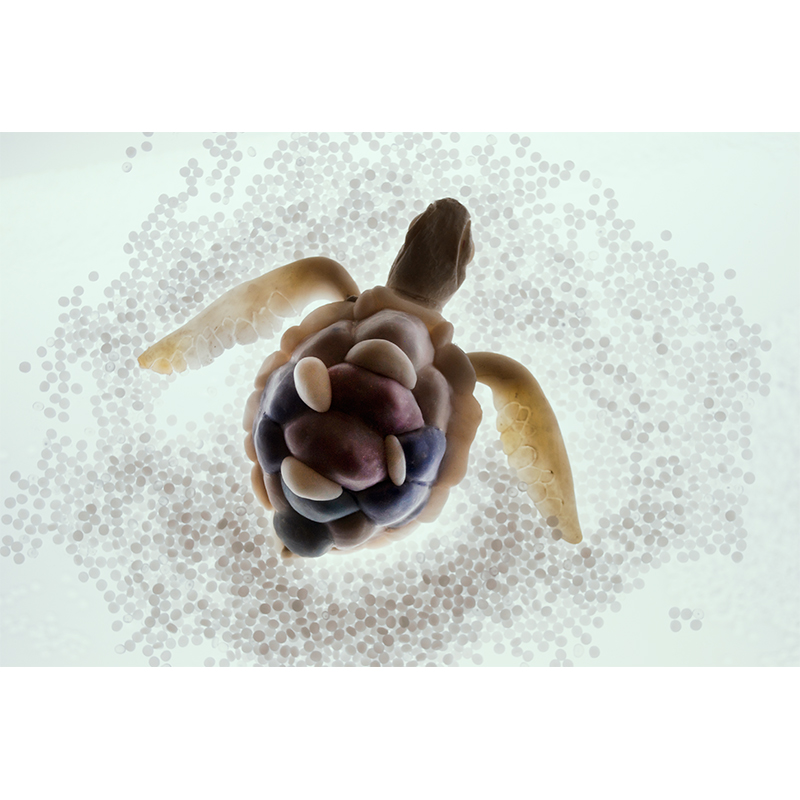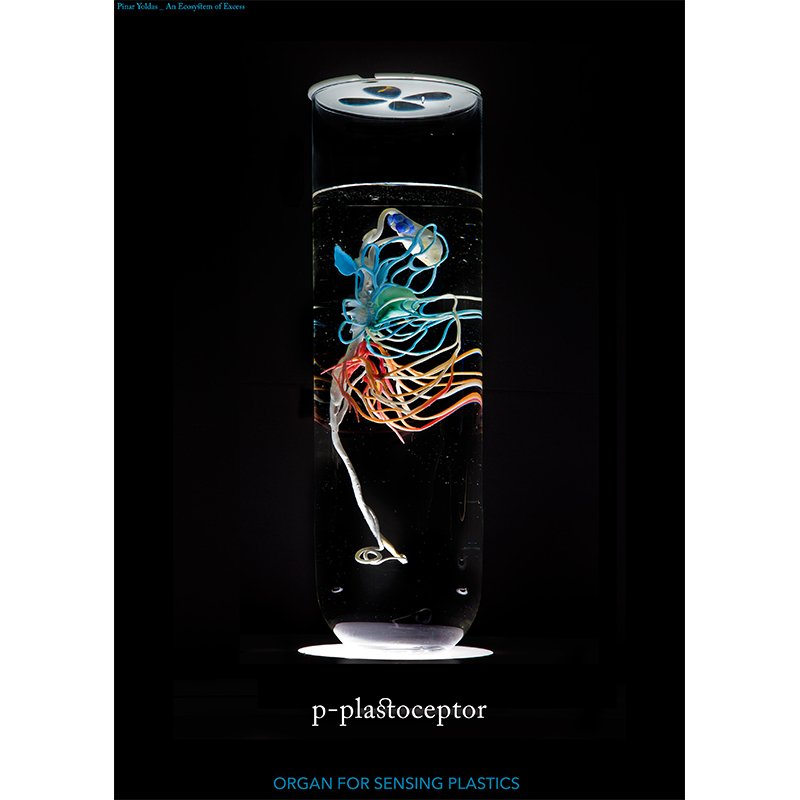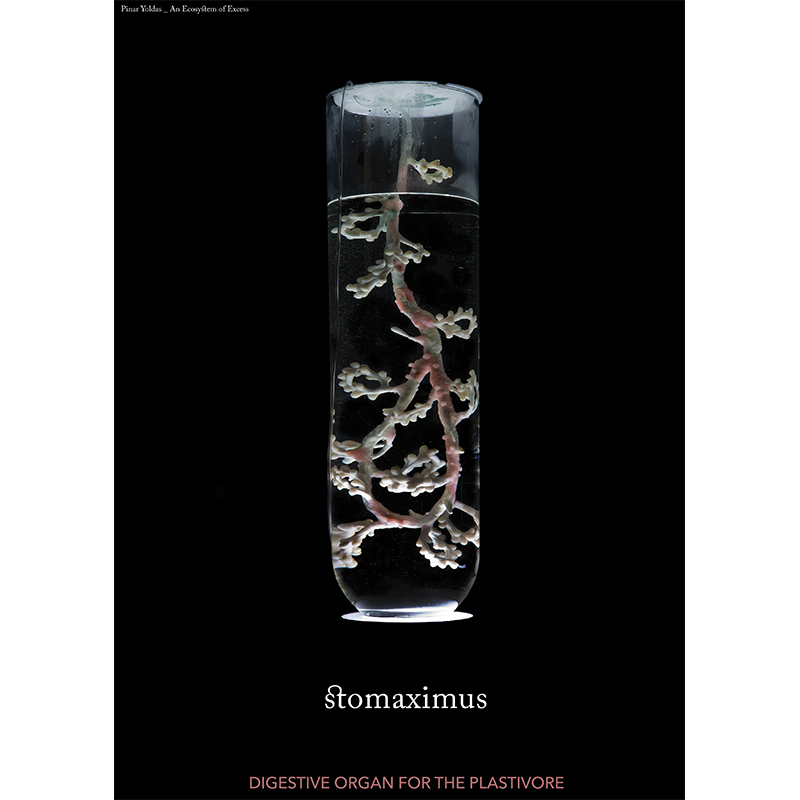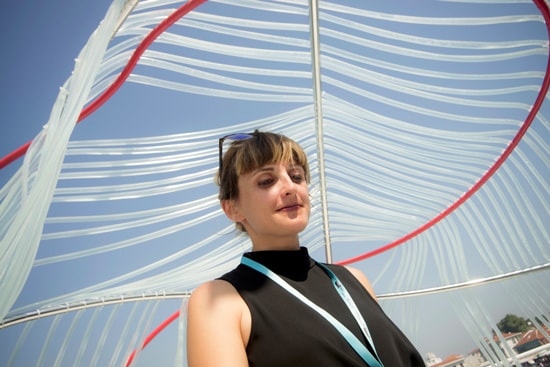
An inconvenient truth: most art about ecological catastrophe is actually pretty boring. Part of the trouble is the temptation to preach or moralize—almost always a disastrous strategy for the artist—or to let political sentiment, rather than curiosity, drive the creative process. Half a century since the birth of the modern environmental movement, artists committed to its program continue to rehash the same once-shocking images of stupefying waste and ruin, producing manifestoes and works of photojournalism that privilege confrontation over introspection. Their work is designed to inspire activism rather than new lines of thought about man’s relationship to nature. There are rare and famous exceptions, such as Robert Smithson’s “Spiral Jetty,” but there is no nature art in the sense that there is something called nature writing.
And what is nature, anyway? The Turkish-born artist Pinar Yoldas believes we have not yet confronted this question. We are pretty sure of what nature is not (or what it no longer is)—fearsome jungle, magic forest, Walden Pond, Caspar David Friedrich, corporate tours of Everest, endless bounty, helpless victim, mother—but a positive definition for the twenty-first century eludes us.
The most sublime work of art on the subject of nature is probably the Great Pacific Garbage Patch, a collaborative man-made sculpture currently on display in the middle of the Pacific Ocean. A sludgy gyre of photo-degraded garbage thousands or perhaps millions of miles across, the Garbage Patch dwarfs “Spiral Jetty” as well as the Nazca Lines and every city on earth. It is a pelagic plastic swamp, a vast vortex of non-sustainable waste. This object, or hyperobject, fascinates precisely because of its elusive ontological status. Could it be art? Is it simply trash? Or is it the new nature: a man-made environment rich in evolutionary potential?
Yoldas believes it is the latter. Her mixed-media work An Ecosystem of Excess imagines the plastic vortex as a primordial soup for new Linnaean developments: a bestiary of birds that subsist on plastic bottle caps (thereby adopting the colors of corporations), balloon-eating turtles, and bacteria barfing up new defenses against our polyvinyl excrement. The artist has also designed an anatomy of organs that digest or dissolve polyethylene, nylon, and acrylic, “keeping the organism free of endocrine disrupters, carcinogens, and other plastics-related obnoxiousness.” Half–freak show, half–museum of natural history, Ecosystem depicts the literal afterlife of humanity’s waste, including a host of plastivores and other plastosensitive creatures better equipped than we are for the world we’re in the process of leaving behind.
Yoldas, who received a 2015 Guggenheim Fellowship, is a media arts and sciences PhD candidate at Duke University. She also holds a BA in architecture, an MA in visual communication design, an MS in information technology, an MFA in design media arts, and a certificate in cognitive neuroscience. For all her academic polymathy, she describes herself as an autodidact in the arts, having taught herself to draw as a child in Denizli. She is doggedly interdisciplinary and light-footed on almost any subject of conversation, breezily navigating C.P. Snow’s “two cultures” as though channel surfing. Her work retains the seriousness of environmentalism’s early thinkers. (One of her current projects reimagines Rachel Carson’s Silent Spring as a dinnerware set with toxic dimensions.) But she does not moralize. In her mind, the damage may already be done—we have fucked up too many ecosystems beyond policy-driven repair—and the best we can do today is speculate, or in her words “futurecast,” on what might happen next. Much of Yoldas’s work falls into the category of speculative biology, according to which she imagines and models the biological effects of our current catastrophe. As such, she owes as much to William Gibson and Ursula K. LeGuin, her spiritual siblings in the sci-fi world, as she does to garbage-curious contemporary artists like Kurt Schwitters and Chris Jordan.
I spoke with Yoldas in Berlin a few hours before she had to catch a flight to Turkey, where she had recently participated in the Istanbul Biennale, and where she was about to debut a solo show at EKAV Art Gallery. (She also has upcoming shows in Moscow and New York.) We chatted over breakfast in Schillerkiez, the sunny, tree-lined neighborhood of Neukölln where she has lived, off and on, for several years.
—Ben Mauk for Guernica
Guernica: Your academic background encompasses architecture, design, neuroscience, and IT, but no formal training in the arts. When did you begin to consider yourself an artist?
Pinar Yoldas: It started in LA. For the longest time I didn’t think of myself as an artist. I came from an architecture background in Turkey, where I grew up the child of an architect and a physicist, and where as an adult I was doing a lot of design work, particularly in interface design. But I moved to LA to study computing because I began to feel that computing was the future of design. That notion was pretty new at the time: algorithmic architecture was new, computing in design existed but was still new and exciting, and being young I was drawn to what was new and exciting. At UCLA I studied with Casey Reas, who together with Benjamin Fry started this programming language called Processing for visual designers. It simplifies things for artists. And it created this whole scene of quasi-programmers, quasi-designers, and I was drawn to this interdisciplinary culture.
Guernica: But you were also drawing from a very young age, weren’t you?
Pinar Yoldas: I started drawing before I could speak. I was nine months old when I started holding a pencil—which is actually dangerous. Why did my parents let me do that? But my dad is an architect, so I must have been inspired. He probably gave me his pencil. When I was one and a half, my parents started collecting these drawings, and when I was five they put on an exhibition at the Denizli public library of 4,000 of my drawings. Of course I don’t remember it, or I remember it vaguely, just having fun. I think I was very good, either because of natural talent or just because I’d spent thousands of hours being very single-minded about drawing as an activity. I had a really long attention span.
Guernica: And there was your interest in the environment.
Pinar Yoldas: I think I was an ecological activist even back in Turkey, although I didn’t know it at the time. My hometown, Denizli, is one of the fastest-growing cities in Turkey, and I remember my father, who had been active in the ’68 movement, protesting the air pollution there when I was a child. The protest managed to enact some reforms, and that was an influence on me. Then I was seven when Chernobyl happened, which was also the year my sister was born, and as a child I was responsive to this. I was listening to these Save the Rainforest albums while all my friends were listening to Metallica. But the most important factor was that I was also a big science-fiction fan growing up. I had all sorts of ideas about how we could improve our urban lives, and I guess I assumed this was what everybody did with their time. I read all the American and then all the Russian science-fiction writers, and then I discovered Ursula K. LeGuin when I was about twelve, and let me tell you: the Earthsea books were my Harry Potter. I was blown away by them because I was already thinking at the time about androgyny and gender.
Growing up in Turkey as a girl, you realize society perceives you differently than your family does. I had a very progressive family, but the society—the Muslim society—while not as restrictive as, say, Saudi Arabia, is different in Turkey. I couldn’t wear shorts out in public, for instance, without attracting stares and nasty comments. Then you’re a teenager and it’s an awful time. I didn’t like the fact that I was a girl; I wanted power. For a long time you think you don’t have a gender, but then you find out. Things change. And I went to a science high school where there were maybe four girls in any classroom. There was a lot of pressure on me to prove that I was good enough, or as good as the guys. So I started to develop this awareness about my role in society as a girl, as a female, and reading LeGuin gave me a perspective on how things could be different, both in the world of gender politics and more generally. She had all these social setups: marriages between four people, or a woman changing her gender to male, or the way animals experience their sex differently. I also liked that she’s not Arthur C. Clarke, exactly. She was not obsessed with the technological aspects of society, like how some futuristic rocket engine worked. She would talk about emotions and social structures. She’s more like an anthropologist of the future, which makes sense, since she’s the daughter of a very famous anthropologist herself. After that I started drawing these purely androgynous figures in high school. She inspired me more than any visual artist; in fact I wasn’t inspired by any visual artists except maybe Egon Schiele and Alphonse Mucha. Very detailed stuff, very anatomical, but also romantic.
So I had this vast spectrum of interests and I wanted to do things where I could merge them all. In college, architecture was a conscious choice, since I didn’t dare to be a full-time artist, and I figured architecture would allow me to stay in touch with my creative side while pursuing something more scientific. That was a mistake, of course, because of the strictures of the Turkish educational system. I would be penalized for drawing some design in watercolor. And at UCLA, when I reached the heart of this programming design culture, I realized that activism alone didn’t satisfy me, either. I wanted to do something more substantial with my work.
When people voted for Dick Cheney and the other Republicans, a mechanically controlled raccoon skull attached to the top of the voting booth would scream.
Guernica: Can you talk about your first attempts to merge your interests?
Pinar Yoldas: The first piece I made was a device that shocked people when they swiped their credit card. It was just a literal and linear connection between excessive consumption and ecological disaster. Another work I designed was a voting machine for the 2008 election. When people voted for Dick Cheney and the other Republicans, a mechanically controlled raccoon skull attached to the top of the voting booth would scream. If there were successive votes, it would scream longer. The idea was to make an orchestra of these skulls that represented endangered species or nonhuman animals that were affected by our political decisions. My goal was to establish a link between the election and global environmental concerns.
Guernica: Where did your interest in “speculative biology” originate?
Pinar Yoldas: Coming to LA from Turkey, I experienced culture shock in a conventional sense—inevitably—but it was also the first time I paid attention to the amount of trash I created. In Turkey I’d buy a yogurt cup and reuse the container, whereas in the US I was supposed to throw away everything. I’d traveled to the epicenter of throwaway culture. Today, in Turkey, fifteen years later, we’ve since adopted the throwaway culture, but growing up there it wasn’t a part of our lives. We drank from glass bottles. My mom reused everything. Chronologically we were a little behind the US. Then I found out about the phenomenon of the Great Pacific Garbage Patch, which naturally blew my mind. Out there in the Pacific is this island, this vortex of plastic trash. I started doing more academic research on plastics and pollution when I got to Duke. I studied plastic’s connection to postwar American culture, how disposables became mainstream. I felt like I’d discovered an ontological turn: the birth of plastics. My next step was to imagine life-forms that might emerge out of the contemporary ooze. The theory of how life started in the ocean is well-known: biogenesis four billion years ago, the first proteins form, the first life-forms emerge, blah blah blah, and here we are. So I asked: What would happen if life started in the ocean now? Which of course is happening anyway, since new life-forms are added to the world every day. What if new creatures emerged that could live off of plastics? I challenged myself to design a new ecosystem of plastics. Clearly I’m interested in synthetic biology as a methodology, and in where biology is headed. I see biology as ideology.
Guernica: It’s impressive how scientifically plausible all the creatures in An Ecosystem of Excess are—at least to a non-expert—and how matter-of-factly their evolution is treated, as though we were standing in a natural history museum of the future.
Pinar Yoldas: I designed organs that metabolize or sense plastics. I also designed birds that I call “Pantone Birds.” These birds obtain corporate colors after eating, for example, plastic bottle caps for eons. The birds are attracted to particular colors of bottle caps, and just like flamingos are colored by the krill that makes up most of their diet, you have Coca-Cola-colored birds, Dasani-blue birds, and I had Pantone colors assigned to each bird. Through that device, I was able to talk about the fact that bottle caps are thought to kill 100,000 birds a month, or something like that. They are birds’ number-one enemy. I designed a turtle that eats balloons to talk about this phenomenon of balloon pollution in the Pacific, since it turns out turtles prefer to eat balloons. Each creature had a framework for talking about how organisms today are being affected by the plastisphere. So there’s a stomach that can digest sixteen types of plastics, and a kidney to talk about BPAs that leech into the sea.
Guernica: And your ecosystem has since found some parallels in the scientific world.
Pinar Yoldas: Yes, take insects, for instance. I found a paper written by an eighteen-year-old who is now a scientist, Miriam Goldstein, and she looked at the correlation between the number of insect eggs and the concentration of microplastics on the vortex. It’s a great finding. Aquatic insects don’t like to live in the open ocean, so they lay more eggs in areas where we have these microplastics floating around. The microplastics serve as a habitat where they can lay their eggs. For my exhibit I followed Linnaean taxonomy, starting with bacteria and moving upward. I was also working with this scientist Linda Amaral-Zettler, who discovered a new family of microorganisms, bacteria that emerged on the vortex, and they called this group of microorganisms the plastisphere. Beautiful.
Guernica: Just as you predicted.
Pinar Yoldas: It happened at the same time. The paper was June 2014. I started thinking about this in 2008. But it was a no-brainer. If an ecosystem is changing, there’s going to be new species in it. All I had to do was extrapolate from this, or exaggerate. And this fits with the neuroscientist VVilayanur S. Ramachandransi’s view of art: he simplifies art to a kind of caricature. He says art is about exaggerating, with the aim of creating superstimuli out of stimuli. I just took one fact and exaggerated it. Another project of mine on display now is called “The Saltwater Heart.” It’s entirely different, an architectural space. I was looking at oceans and ocean health, so I designed a circulatory system to talk about the circulation of the ocean, which is also under threat due to climate change. I’m not working directly with climate change, but everything is related. My domain is man-made extreme environments. I’m looking at these extremities where life is challenged in unforeseen ways thanks to the emergence of mankind.
Guernica: The Anthropocene.
Pinar Yoldas: This term is becoming more and more popular. Then you have people who are already totally over it, who talk about the post-Anthropocene! I guess I could consider myself post-Anthropocene. For An Ecosystem of Excess, the creatures are meant to emerge when there is no human life anymore. So it imagines a post-Anthropocene world. But then, in the post-Anthropocene, there would be no art. So maybe it’s not a great term.
Guernica: You also describe yourself on Twitter as an eco-futurist.
Pinar Yoldas: Eco-futurist is more appropriate. It could mean multiple things: a futurist with a lot of ecological tendencies, or it could refer to the Futurists, the Italian movement that emerged during World War I. I admire some things about them, for instance their fascination with machines. I’m critical of the machismo, I guess…
Guernica: And the fascism?
Pinar Yoldas: The fascism, yes, and the fascination with war machines. But what I like about them is the dynamism and momentum they had. One of the things that stands out for me is their fascination with speed and force. One of my favorite architects was a Futurist who died very young, Antonio Sant’Elia. His work contains this fearless speculation. I love the work of many speculative architects, like Sant’Elia, or, more recently, Lebbeus Woods, who make really innovative buildings on paper that might never exist. In fact I’m much more influenced by architects than by contemporary artists. But back to the point, I would like an ecological moment to have the passion and force and speed and spirit of the Futurists. One problem with the green movement is they’re labeled as tree huggers. Their cultural representation is kind of passé. They’re called hippies, that sort of thing. I dress kind of like a hipster, and sometimes people see my work and say to me, “But you look normal, you don’t look like an ecological activist!” Whatever that means. There are these cultural attitudes: Greenpeace people in tie-dyed t-shirts.
Eco-futurism is an attempt to better understand nature in order build a new culture that has more to offer. Eco-punk, I don’t know.
Guernica: Part of that image problem is also the regressive utopianism we associate with environmental activists, right? The idea that they want to inhabit some idyllic hunter-gatherer past, which suggests a fear of technology.
Pinar Yoldas: Definitely. It’s escapism of a sort. And entirely wrong. We are living in a time when we really need to define what nature is. We have these images of nature that are also false. Eco-futurism is an attempt to better understand nature in order build a new culture that has more to offer. Eco-punk, I don’t know. I’m always thinking of the future of the artist, or the future of the designer. Say you’re a designer, and you design a chair or lemon squeezer or a lighting fixture, which we all need. Everybody loves nice lighting fixtures and chairs. But don’t we have enough of these well-designed chairs? The definition of design has to change. We need subversive objects to create a discourse, not to solve a problem. We need critical design. I did a project similar to Ecology of Excess years earlier, called AlterEvolution. In LA I’d first read the phrase “cage-free chickens,” which amazed me. Aren’t chickens supposed to be cage-free? So I designed chickens without legs or wings. I took out the brain, so that only reproductive, circulatory, skeletal, and muscular systems remained. This was a critique of the food industry, of course. I called it biological minimalism at its best. Or take the issue of human engineering. There are already clinics in LA that let you pick your child’s eye color. Why waste time with eye color? Go straight to the prefrontal cortex! I’m not just interested in protecting the environment. I want to know how we perceive ourselves as humans and what we are actually doing as pure consumers—with eugenics, for example, which has to do with human pride, this idea that we are the pinnacles of evolution. This kind of mentality is what I’m criticizing.
Guernica: I’ve noticed that certain psychological profiles recur in your descriptions. For example, you sometimes talk about “pure consumers,” meaning people who consume and dispose of trash uncritically, and who are completely invested in throwaway culture. But do you really think there’s a meaningful difference between those people and the rest of us, who may have huge ecological footprints but feel some guilt over that fact?
Pinar Yoldas: Of course there’s a difference. For the second type, every time you consume you experience cognitive dissonance. But I think about this a lot. Once I was biking in LA and was hit by a woman driving an SUV. She got out of the car and walked toward me, but stopped some distance away. Meanwhile, I’d broken my clavicle, so I thought my neck was broken. I thought I was dying, and all I can see is this woman standing there. And she pointed at me and said, “It was your fault!” That’s what she said! So in my head I merged the whole concept of an SUV, which I dislike already, with this type of person so eager to deflect blame, this personality type who is totally selfish and who has no empathy: a sociopath. Then I thought, well, maybe she has so completely adapted to this plastic metal shell that she’s lost touch with humanity. She becomes this creature that inhabits a cube or apartment and then moves from one to another metal or plastic container. She’s always contained. At the root of all these ecological problems is our psychological makeup. On the other hand, you can’t just blame SUV drivers. No matter how we consume or think about consumption, there’s going to be a lot of climate-related problems in the coming years: migration, climate change. It’s happening already.
The bottom half of the world is already living in the future that has not caught up to us.
Guernica: But the changes may not be immediately apparent to those of us sitting here in Berlin.
Pinar Yoldas: As William Gibson says, the future is not evenly distributed. The bottom half of the world is already living in the future that has not caught up to us. We, too, will adapt. It will not happen overnight, like in that Hollywood movie, The Day After Tomorrow. It’ll be gradual in the sense that it will take a decade or two or three, but this change is happening. We’ve fucked up a lot of ecosystems to the point of no return. We’re going to have Mad Max somewhere. Policies are unlikely to change. In places like Turkey, at least, policies won’t change. In Turkey they are following a paradigm that has been exhausted by the West a long time ago. I don’t think there will be any changes in Turkey any time soon. Some countries are not as smart as others.
Guernica: How do you feel about academia, having spent so much of your life inside of it?
Pinar Yoldas: I’ve been in academia forever. I respect academia. What can I say? Anyone who seeks knowledge—I mean, I know that it sucks sometimes. But schools are great. Schools and gyms are awesome. I like these things. And parks. Not shopping centers. Growing up in Turkey slowed me down. I had to work for other people, there wasn’t funding or support for the arts. It might have been different if I’d grown up elsewhere, but academia has helped me stay in touch with knowledge. Getting all these degrees was the only way for me to follow all of my interests. Today, I’m working on many different projects. One is “Distilling the Sky,” which is a structure that sucks huge amounts of air from the atmosphere, a kind of filtering mechanism or tower. We condense a whole neighborhood into a couple drops of fluid. The goal is to make ink out of air pollution and present this ink to poets and writers. I have sketches of this, but not the real thing yet because of funding. Maybe in 2017. And I’m working on a project involving Rachel Carson’s Silent Spring, looking at highly toxic protein structures. How they fold and unfold.
Guernica: You inhabit both scientific and artistic communities. What do you wish each domain would learn from the other?
Pinar Yoldas: I’ve been on both sides. I’ve met scientists so artistically gifted that it would make some artists look bad, and I’ve met artists so analytically gifted it would make some scientists look really dull. But I never received a decent art education, and I think that was a good thing in my case. I was able to learn about other fields. If you look at art schools, we may teach programming in some schools but they will know nothing about sciences, and this is something that could be easily fixed by creating interdisciplinary programs. Both scientists and artists use the same parts of the brain for creativity. We employ similar centers. Sometimes at scientific conferences people question if my organisms are actually real, or else they discuss how one of my organisms could be built. I’m happy with that response. I actually feel more at home there. But I don’t want to go into the “art school/science school” thing. As an artist, you need to know about textures and emotions. It’s sensory training, or even affective engineering. Artists are researchers of the affective spectrum. People will criticize me for saying so, but there is a science to it—to making art.
